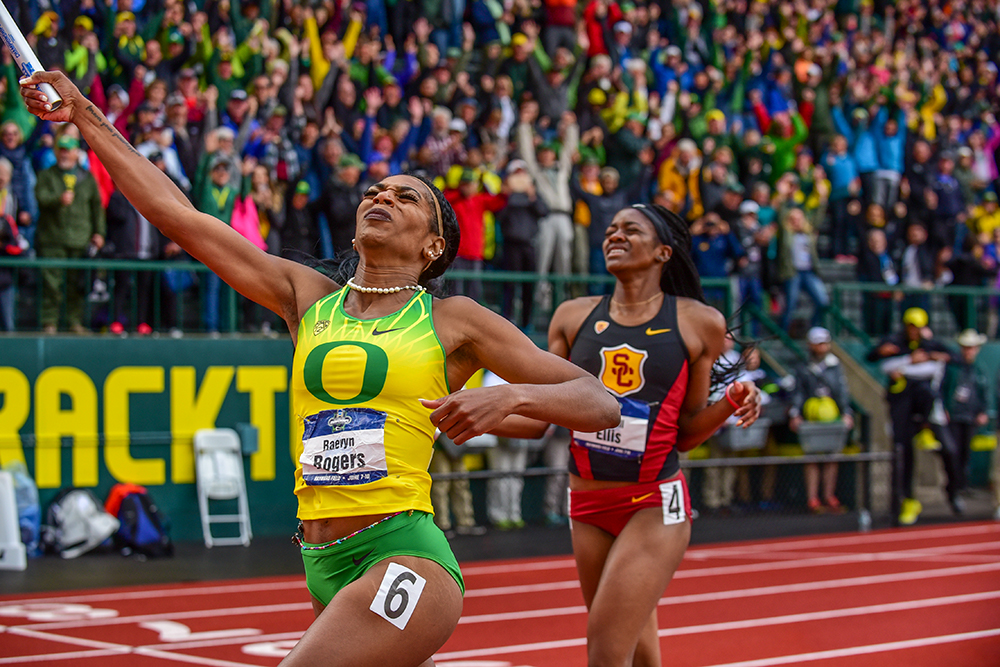
FOR RAEVYN ROGERS, who wound up the ’19 campaign on the superb high note of a silver-medal run at the World Championships, lining up to contest the Olympic Trials 800 in June will mark not just another chance to vie for her first Olympic berth, but also a homecoming. To her alma mater and its fans. Hayward Field is the spot in which the Houston native wowed the famously engaged local track nuts by capturing three NCAA outdoor crowns, 2015–17 before going pro a year early. The 23-year-old Texan relishes the prospect of running before the Hayward faithful again and figures their support can’t hurt her OT prospects; she placed 5th as a Duck soph in ’16.
Rogers even has a nickname for the all-new stadium in which the Trials will be run. “My creative side thinks of it as a dinosaur,” she says, “It’s those ribs” (the striking architectural flourish that will support the state-of-the-art track venue’s partially overhanging translucent roof once construction is complete). But the magic of Hayward—old or new—asserts Rogers, is the fans. “I’m excited for the chance to run in front of the people who saw me in the [’14] World Junior Championships even before I went to college and then supported my development in college.”
Rogers’ rise to Doha medalist last year, however, owes just as much to coach Derek Thompson’s deep 800 training group, which includes Ajee’ Wilson. After finishing her degree, Rogers decamped to Philadelphia and its 2-lap power enclave before the ’19 campaign; before that Thompson had guided her training from afar in ’18. The rewards have been obvious and more than worth the initial uncertainty, which Rogers candidly admits she felt.
2019, she says, was “a little mentally tough just because of making the transition from training by yourself to training with other people, and people who are stronger than you in different areas.” PRs in other events highlight some of the skills diversity: Wilson, ’19’s No. 1 World Ranker, has run just 53.63 for 400 (albeit 6 years ago) yet has 4:05.18 endurance in the 1500. Rogers, by contrast, turned a 49.77 relay split at the ’17 NCAA and has never raced a 1500. A year-plus into working out together, Rogers says, “It’s immensely beneficial that I know [Wilson] is going to be pushing out [on longer reps].” Rogers gets to pay it back with her wheels when the intervals are shorter and quicker.
That’s the on-the-track scenario. Wilson as a person earns even greater encomiums from Rogers: “She has a genuine heart. She doesn’t have any malicious intent with anybody.” Before the Doha final, Rogers says Wilson gave “me and [U.S. teammate Ce’Aira Brown]—who had made it through the 800 rounds—bracelets that she had chosen for us that [represented] values that she felt pertain to us. So definitely a mentor type of vibe, like she’s definitely a big sister. So she knows what she can do and of course she expected more [than bronze in the Worlds final], but I also feel like she’s learning, as well, because you’re never too old to learn.”
For races, that training synergy with Wilson and the rest of their group coaxed Rogers out of the shell in which she dwelled in ’18, when she felt “I don’t know if I would say ‘shy,’ but I guess less confident in races to where I would sit back and not want to be in the mix, or I was still trying to figure out where I could separate myself from the other athletes.”
The Paris DL race 5 weeks before the Worlds final last year dealt a cracking blow to her reticence. Rogers opted to blast out hard behind rabbit Chanelle Price, ripped through the lap in under 56.0 and 600 in 1:26.56—and paid the price. U.S. rival Hanna Green won in 1:58.39 as Rogers slipped to 6th in 1:59.50. Nonetheless, for Rogers the outing brought a huge confidence boost. “I just owned it and I went for it,” she explains. “And I felt amazing even coming through at like 55, I felt great. I wasn’t tired. I wasn’t tired throughout the whole race and even when I got lactic at the end, I still wasn’t tired. And so that race just showed so much to me about my abilities and what I can do.” Ditto the WC final in which she exploded into sprinter mode for the mass-kicking conclusion and sped from 7th with 100 to go to 2nd.
Rogers declines to predict how the Olympic Trials final will play out. She prefers to wait and see, “be ready for whatever happens,” but she is aiming for a post-Trials schedule unlike ’16’s. “I got a job at Nordstrom Rack,” she says, “because when you’re a college athlete, opportunities to earn some money are rare. I learned a lot about retail and I enjoyed the team aspect of it.”
She has reached a different phase of her developmental arc this year and intends to make the most of it. “This is the important part before I have my peak time in my career,” Rogers says, “where I’m learning from races, I’m learning the importance of faith in yourself and confidence, all these values that are kind of going to be instilled in me so that I’m a little bit more secure in myself when I do have my time where everything just goes down.”